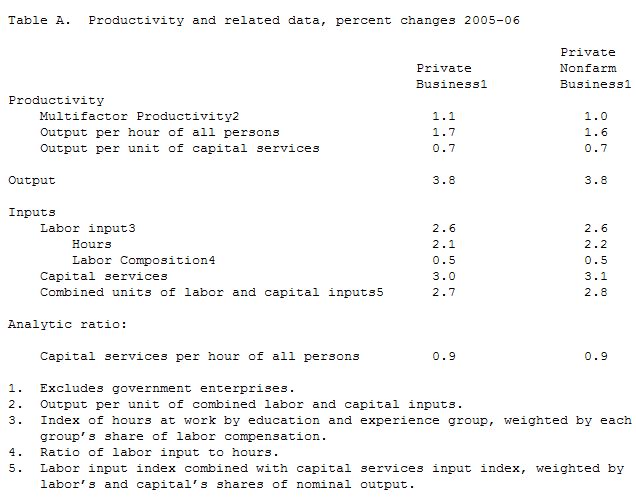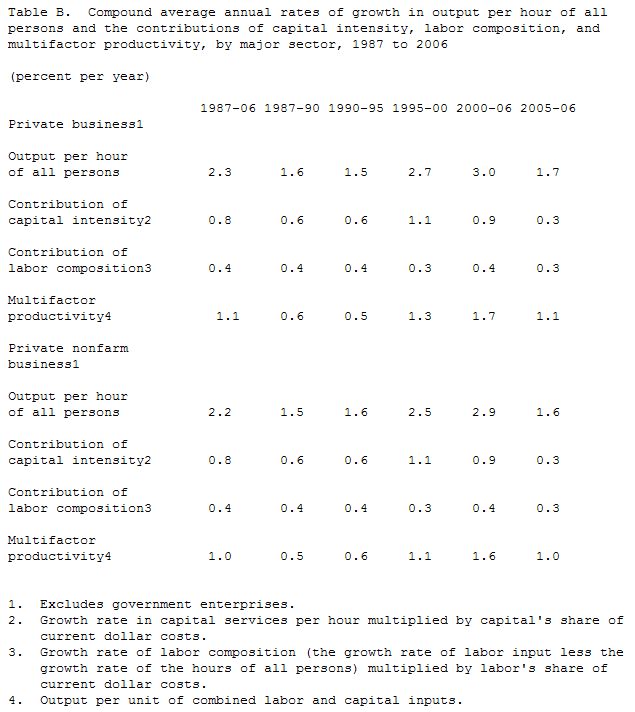
The estimates of multifactor productivity in the private business and in the private nonfarm business sectors for 2006 both show the slowest annual rates of growth since 2001. The 2005-06 annual changes are summarized in tables A and B, table B also presents data showing historical trends.
Multifactor productivity growth is designed to measure the joint influences of economic growth on technological change, efficiency improvements, returns to scale, reallocation of resources, and other factors, allowing for the effects of capital and labor. Multifactor productivity measures differ from labor productivity (output per hour worked) measures that are published quarterly by BLS since they include information on capital services and other data that are
not available on a quarterly basis.
A change in multifactor productivity reflects the difference between the change in real gross domestic product for the sector and the change in labor and capital inputs engaged in the production of this output. The output measures for the private business and private nonfarm business sectors contained in this release are similar to the indexes of output for business and nonfarm business used in the quarterly labor productivity measures but the output of government enterprises is omitted. Conceptually, change in multifactor productivity reflects the change in output that cannot be accounted for by the change in combined inputs of labor and capital. In contrast, a change in labor productivity reflects the change in output that cannot be accounted for by the change in hours of all persons engaged in production.
Private business sector
Chart 1 shows the annual indexes of multifactor productivity, output per hour worked, and output per unit of capital services during the 1987-2006 period for the private business sector. Over the last 19 years, capital services have grown more rapidly than hours in the private business sector, and the skills of workers - as measured by their education and work experience - also have risen over this period. These shifts toward more capital intensive production and toward workers with more human capital have supplemented labor
productivity growth, usually allowing output per hour to grow at a faster rate than multifactor productivity.
Multifactor productivity rose 1.1 percent for the private business sector in 2006 (see table A). The multifactor productivity gain in 2006 reflected a 3.8 percent increase in output and a 2.7 percent increase in the combined inputs of capital and labor.
Capital services grew 3.0 percent. Labor input posted an increase of 2.6 percent, as both hours worked and labor composition rose. The capital-labor ratio (capital services per hour of all persons) increased by 0.9 percent.
Labor input reflects the change in hours at work adjusted for the effects of changing labor composition. The increase of labor input was due to an increase in hours at work of 2.1 percent and an increase of 0.5 percent in labor composition. Labor productivity (output per hour worked) increased 1.7 percent. Capital productivity (output per unit of capital services) grew 0.7 percent. As shown in table B, the contribution of labor composition rose 0.3 percent from 2005 to 2006, while the contribution of capital intensity growth gained 0.3 percentage points over the same period.

Private nonfarm business sector
Multifactor productivity rose 1.0 percent for the private nonfarm business sector in 2006 (table A). The multifactor productivity gain in 2006 reflected a 3.8 percent increase in output and a 2.8 percent increase in the combined inputs of capital and labor.
Capital services grew 3.1 percent. Labor input posted an increase of 2.6 percent, as both hours worked and labor composition rose. The capital-labor ratio (capital services per hour of all persons) increased by 0.9 percent.
The increase of labor input was due to an increase of 2.2 percent in hours at work and an increase of 0.5 percent in labor composition. Labor productivity (output per hour worked) increased 1.6 percent. Capital productivity (output per unit of capital services) grew 0.7 percent. The contribution of labor composition rose 0.3 percent, while the contribution of capital intensity growth gained 0.3 percentage points from the previous period (see table B).






